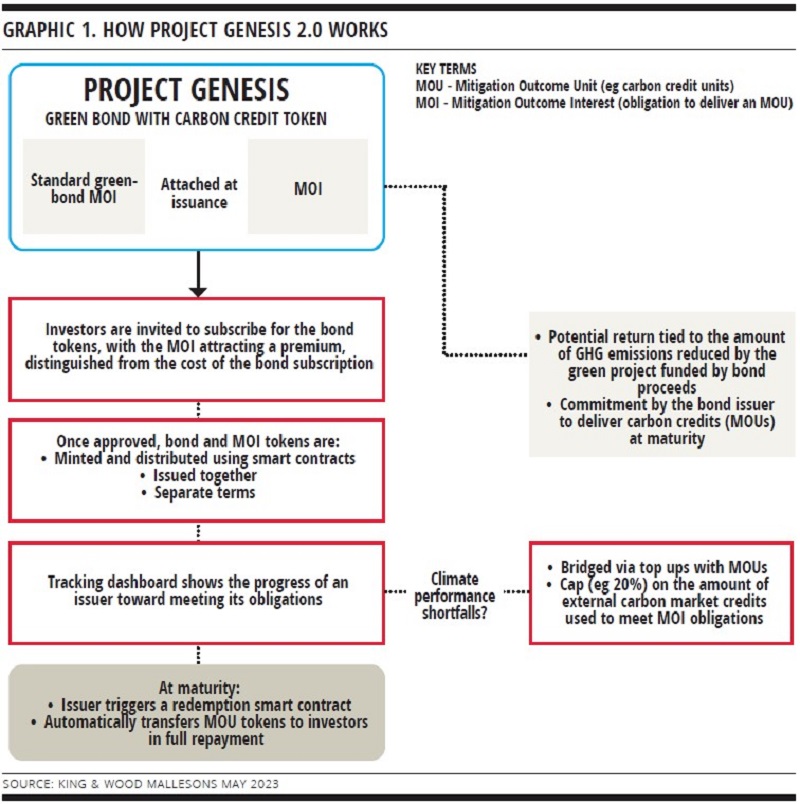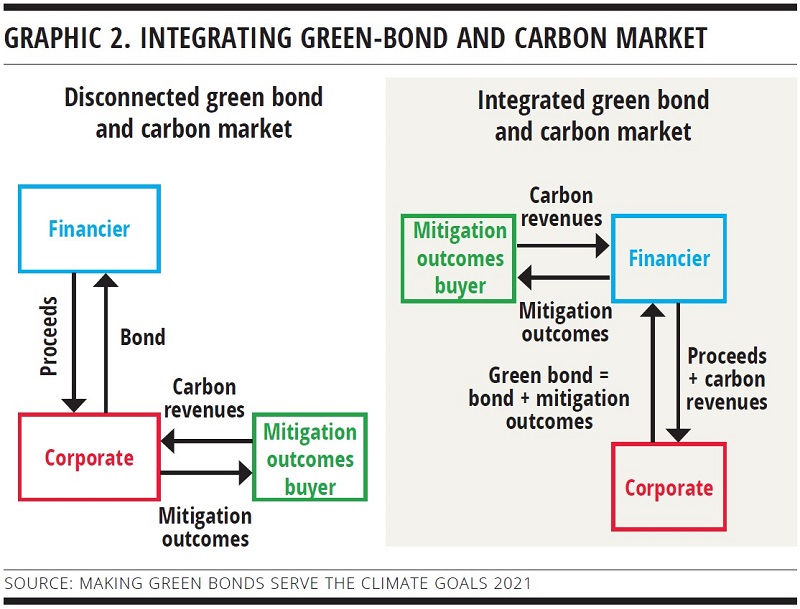
Blockchain breakthrough
Green bonds have surged in use in recent years, but the future growth and effectiveness of the market is threatened by difficulties aligning the credit quality of an issuer and ensuring proceeds are used to fund green projects. In the first of a pair of articles discussing the cutting edge of sustainable finance, King & Wood Mallesons partners Jo Dodd, Urszula McCormack and Dale Rayner discuss tech-based solutions to the problem.
The volume of green bonds issued globally topped US$2 trillion by September 2022, according to Climate Bonds Initiative. An important instrument in the transition to a net zero economy, efforts to bolster their integrity are critical.
The Bank for International Settlements Innovation Hub (BISIH) in Hong Kong launched an intriguing innovation in late 2022: Project Genesis 2.0. Bringing together carbon markets and capital markets, the technology attaches carbon credit-related digital tokens to green bonds. This reduces the risks of greenwashing by issuers of existing green bonds and simplifies distribution. BISIH shared details of its world-first innovation at the UN Climate Conference in Egypt (COP27).
King & Wood Mallesons (KWM) assisted on the project, which leveraged blockchain, smart contracts, internet of things and digital assets for green-bond distribution and improving transparency on the use of proceeds (UOP). KWM has an ongoing relationship with BISIH and keeps a keen eye on developments. Since the pilot, Hong Kong has taken yet another step in the direction of becoming a global sustainable finance hub by issuing HK$800 million (US$101.9 million) of tokenised green bonds.
REIMAGINING GREEN-BOND VALUE
The problem is that the market is not – or at least not adequately – rewarding investors for choosing green allocations. Green bonds are differentiated in most definitions by reference to the UOP to finance green projects, acquisitions or activities. But the primary driver for investment in most green-bond transactions is the credit quality of the issuer; knowing the proceeds are earmarked to fund green projects is an added benefit.
This is because there is little scope in current markets for investors to be rewarded – other than by meeting their own objectives – for the benefits of green projects being funded with their investments. In addition, the accountability of issuers under existing green bonds is relatively light.
The Project Genesis fix is a world-first product designed to verify green bonds. The Genesis 2.0 instrument addresses these limitations by attaching a carbon credit token to a green bond (see graphic 1). At the same time, this allows the digital issue and trade of carbon credits.
The token attached is a mitigation outcome interest (MOI). This represents an obligation by the bond issuer to deliver a mitigation outcome unit (MOU) – in this case, carbon credit units. The investor pays a premium on investment and receives back carbon credits – the MOUs – to repay the investment at a future point in time when certain greenhouse gas emission reduction goals are met.
The issuer may generate MOUs through activities financed by the proceeds of the bond. It can choose to cover any shortfall with purchased carbon credits, up to a set limit.
The genesis of the digital ‘green bond’ project came when BISIH began exploring the digitisation of carbon-cutting instruments in 2021, with the help of a handful of global banks and advisers including KWM, InterOpera, Allinfra and Goldman Sachs.

By year-end, a first prototype was ready to digitally track, deliver and transfer MOIs. A year later – in October 2022 – the second prototype was launched, introducing an interoperable host chain. On 9 November 2022, Goldman Sachs presented Project Genesis 2.0 to COP27 (see table).
PROTOTYPE PROGRESS FOR BLOCKCHAIN SUSTAINABLE BOND INSTRUMENTS
| Prototype | Launch date | How does it work? | Who was involved? |
|---|---|---|---|
| 1 | November 2021 | Showcased a simulated solution for an end-to-end digital flow for institutional green finance. The straight through process via distributed ledger technology was able to digitally track, deliver and transfer MOIs in addition to tokenising the issuance of the green bond itself. It was able to achieve smart-contract-based delivery of bonds and MOIs, and provided source data transparency enabled by IoT technology. | Developed by Goldman Sachs, Allinfra and Digital Asset. King & Wood Mallesons advised. |
| 2 | October 2022 | Built on an interoperable host chain designed as part of a wider ecosystem. With a combination of blockchain, smart contract and API technologies, it also digitally tracked, delivered and transferred MOIs throughout the full green-bond life cycle. | Developed by InterOpera in collaboration with Krungthai Bank, Samwoo and Sungshin Cement. King & Wood Mallesons advised. |
Source: King & Wood Mallesons May 2023
The features of the MOI closely track the mitigation outcome security proposed by Massamba Thioye of the UN Framework Convention on Climate Change in his 2021 paper on the subject, Making Green Bonds Serve the Climate Goals (see graphic 2).
Thioye identified 11 benefits of integrating the green-bond and carbon markets, as follows:
- Enhanced transparency, objectivity and environmental integrity.
- No need to track the UOP.
- Optimal use of public climate finance to enable impactful climate action.
- Advantages for green financiers, including as a source of capital gain.
- Governments buying – from financiers – mitigation outcomes generated from developing countries can claim the mobilisation of private climate finance for the benefit of those developing countries.
- Operationalising the disclosure of exposure to climate risks and opportunities.
- Turning carbon finance into an ex ante enabler to access the international capital market.
- Benefit compared with the EU taxonomy combined with the EU Green Bond Standard.
- Empowering financiers to play a greater role in addressing climate change.
- Transfer of a tangible product the buyer must pay for as a condition for the bond to be green.
- The bond and the green attributes of the bond, in the form of mitigation outcome, can be sold separately.
KWM’S ROLE
KWM teams across debt capital markets, blockchain and carbon markets came together to assist with the early concept and prepare the template termsheet for MOIs. The early concept involved testing a smart contract involving two limbs.
The first was a digital green bond reflecting traditional debt interests with a traditional fiat currency coupon. The second was digital MOIs that are repayable in carbon credits. These are initially attached to the bond but can be decoupled.
Not only was the concept innovative, but the pilot also involved working through the actual terms of issuance and KWM producing a detailed template termsheet. This required carefully mapping and resolving the legal and regulatory context as well as addressing multiple ‘what ifs’.

